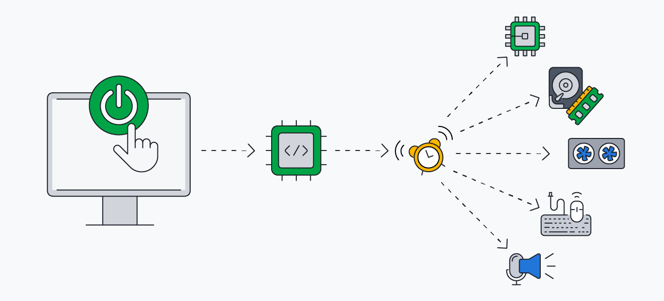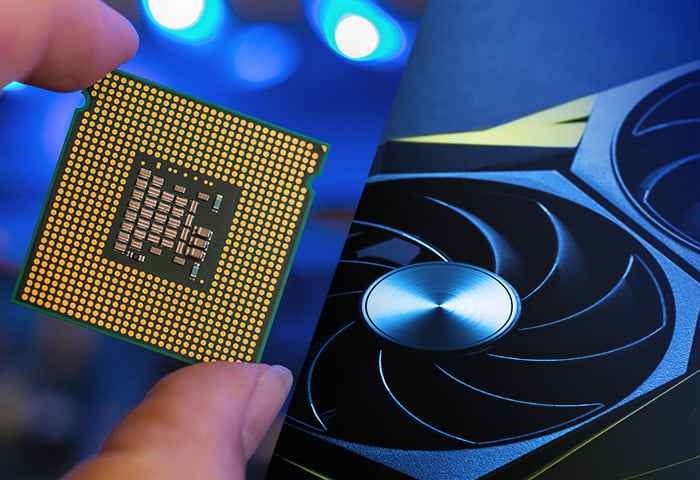What is firmware?
Firmware is a type of software that provides machine instructions to a device’s hardware components, enabling it to function on a basic level. Because firmware is installed by the manufacturer and typically cannot be removed, it is sometimes referred to as embedded software.
How does firmware work?
Firmware works by delivering communications between the operating system and the hardware — firmware essentially instructs a device how to function on a very fundamental level. The name “firmware” comes from this role as an intermediary between hardware and other forms of software on the device.
For instance, when you turn on a device, firmware first activates and begins any processes required to start the device, such as waking up the hardware necessary to begin booting the operating system.
 During start up, firmware activates the hardware needed to boot the operating system.
During start up, firmware activates the hardware needed to boot the operating system.
Because firmware needs to permanently retain information even when the device is powered off, it’s generally stored on the system’s “non-volatile” read-only flash memory (ROM) and functions separately from other types of software installed on rewritable RAM. But how firmware works exactly — and where it’s stored — depends on its specific type and purpose.
Types of firmware
System firmware is the foundational software used for basic computing operations, such as booting up, loading operating systems, recognizing hardware elements, and allowing them to communicate. But firmware can be further categorized according to how far down a device’s software stack it sits.
Here are the different types of firmware that may be found on a device, depending on its level of sophistication and complexity:
Low-level firmware
Low-level firmware is an intrinsic part of a device’s hardware and is stored on read-only memory (ROM) or programmable ROM (PROM) chips that cannot be updated or rewritten. Devices that only use this type of firmware often have a single purpose (think digital alarm clocks or TV remote controls), with the firmware essentially acting as the operating system.
High-level firmware
High-level firmware is installed on a system’s rewritable “non-volatile” flash memory chips rather than ROM, which means that it can be modified and upgraded. Found on devices such as PCs, Macs, and game consoles, it’s called “high-level” firmware because it sits above the low-level firmware in the software stack, and performs more complex instructions and functions.
Subsystem firmware
The definition of subsystem firmware, or device firmware, is a special type of high-level firmware that runs independently of the main system firmware. Examples of subsystem hardware components that typically have their own dedicated firmware include CPUs, sound cards, and monitors.
Are firmware updates important?
Firmware updates are important because they allow manufacturers to ensure their devices remain compatible with new software formats. For example, your phone may require an update to enable it to communicate with a new version of iOS or Android and integrate new features.
But it’s not just a question of compatibility. Firmware updates resolve glitches and bugs,
prevent crashes
, and help stop computers getting slower over time. In addition to fixing performance issues, firmware updates also contribute to enhancing device security.
 The benefits of firmware updates include enhanced compatibility, performance, and security.
The benefits of firmware updates include enhanced compatibility, performance, and security.
What is firmware security?
Firmware security protects against hackers who exploit vulnerabilities in firmware code to gain unauthorized access to a device and install malware or steal data. Historically, firmware security was a particular concern for devices such as routers and servers.
But with the emergence of smart homes, firmware security is increasingly important for ensuring Internet of Things (IoT) devices aren’t an easy target for threats such as firmware rootkits — a particularly stealthy type of malware that hides within firmware code, out of sight of all but the very best antivirus scanners.
When it comes to maintaining the firmware security of your own devices, the most critical element is keeping your firmware fully updated. This is because firmware updates include patches designed to fix existing issues that could be used as an avenue for attack.
What is the difference between firmware and software?
Firmware is technically a type of software, but there’s a clear distinction between the functions of each. Sometimes referred to as “software for hardware,” firmware is not designed to interact with the user, but instead enables the device to function on a basic level and communicate with elements of the wider system.
Software is not directly reliant on a specific hardware component. In this sense, software sits “above” firmware in the system hierarchy. It’s the firmware — alongside its integrated hardware components — that runs software in the form of operating systems, programs, and apps that you interact with.
When it comes to updating firmware vs software heavyweights like the operating system, make them both a priority. If either your firmware or operating system fails, your device won’t work properly. The same can be said for drivers.
Are drivers a type of firmware?
Although drivers and firmware are both types of software that facilitate hardware operations, they serve different purposes. Unlike firmware, which is programmed directly on a hardware device to provide machine instructions, drivers allow an operating system to recognize and communicate with a certain type of device, such as a mouse or monitor, when it’s connected.
What types of devices use firmware?
Firmware can be found in a wide range of modern devices. In fact, almost any digital device — from smart light bulbs to headphones — relies on firmware to function. Here are some common examples:
 Desktops and laptops
Desktops and laptops
The firmware on a computer is known as the BIOS or Unified Extensible Firmware Interface (UEFI) and is stored in the dedicated memory of the motherboard, or logic board on a Mac. Computer firmware is used to launch the operating system. Many peripherals and related devices such as routers also have their own firmware.
 Smart devices
Smart devices
From televisions to fridges, any device that has smart capabilities or IoT connectivity will have firmware. The firmware and software on these will not need to be updated as frequently as firmware on computers.
 Mobile devices
Mobile devices
Phones, tablets, and smartwatches all need firmware to run. The type of firmware will vary due to the differing requirements for iOS on Apple and for Android on devices like Samsung.
 Appliances
Appliances
Appliances around the home that can be programmed, like microwaves and washing machines, will use firmware to communicate instructions and user inputs to the mechanical elements of the machine.
 Cars
Cars
From sensors to navigation systems, much of the technology in modern cars now has its own firmware dedicated to performing specific tasks.
What are the benefits of updating firmware?
A firmware update will improve the stability, security, and performance of your device by including fixes, patches, and compatibility updates. These updates can help your device work with new operating systems or add new features and functionality.
Stability
Implementing firmware updates can help to maintain the stability of a system by eliminating bugs and issues, while also ensuring compatibility with new hardware and software components. The stability of your CPU can be assessed with a stress test to identify performance issues.
Security
Firmware is generally vulnerable to attack as it is rarely designed with security measures in place. This can make it simple for exploits to be added to the firmware’s code without being detected, creating an open door for malware.
Applying security fixes as soon as they’re available is vital for protecting your firmware and patching potential exploits and resolving vulnerabilities that could lead to your activity being monitored, your data being stolen, or your system becoming unusable.
Performance
Firmware updates improve performance by ironing out glitches and inefficiencies in hardware operations and enabling new features, such as compatibility with new formats of music and video. Sometimes, older devices seemingly on their last legs can be revitalized by a comprehensive firmware update.
How to apply firmware updates
Many device manufacturers provide regular over-the-air (OTA) updates and deliver them with a firmware update or notification, meaning that all you have to do is click to install the update. If you have to apply the update manually, proceed with caution — installing the wrong type of firmware could cause your device to malfunction.
Follow these tips to update your firmware (also known as flashing your firmware) safely:
-
Identify the exact model and firmware version your device is running. This can often be found in the settings menu on the device or in the app used to communicate with it.
-
Find the manufacturer’s website and search for your exact model. Only download updates from the official website to avoid inadvertently installing malicious software. Some manufacturers may provide a tool that will identify and download the latest update for your system.
-
Make sure you have a reliable power supply and do not install updates on battery power. Firmware is essential for your device, so a failed installation due to a loss of power could “brick” it, rendering it completely unusable.
-
If you have issues with your firmware, do not uninstall it. Instead, upgrade or replace it with a different version.
-
If you are using a Mac, you may need to enter a firmware password. This can be turned on or off in macOS Recovery > Utilities > Startup Security Utility (or Firmware Password Utility).
Keep your computer running smoothly with AVG Driver Updater
Keeping your firmware updated is important, but it’s just one part of overall device performance. AVG Driver Updater automatically scans for outdated or missing drivers, runs advanced malware and compatibility checks, and installs the latest version for maximum performance and security, with minimum hassle. Install AVG Driver Updater today to keep your machine running smoothly.

 During start up, firmware activates the hardware needed to boot the operating system.
During start up, firmware activates the hardware needed to boot the operating system. The benefits of firmware updates include enhanced compatibility, performance, and security.
The benefits of firmware updates include enhanced compatibility, performance, and security.




